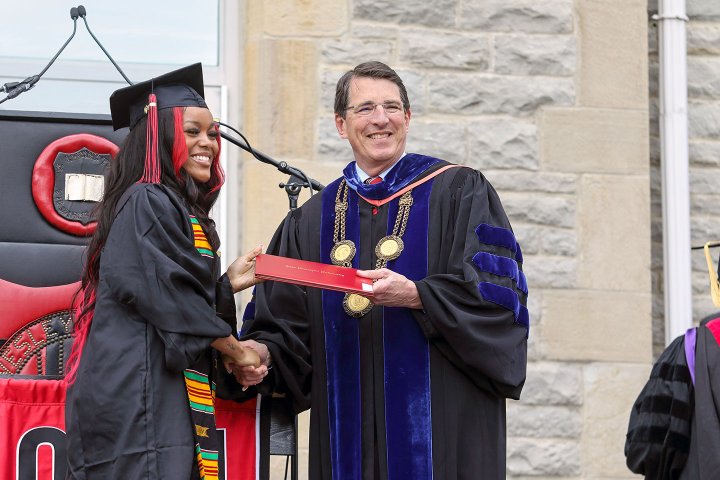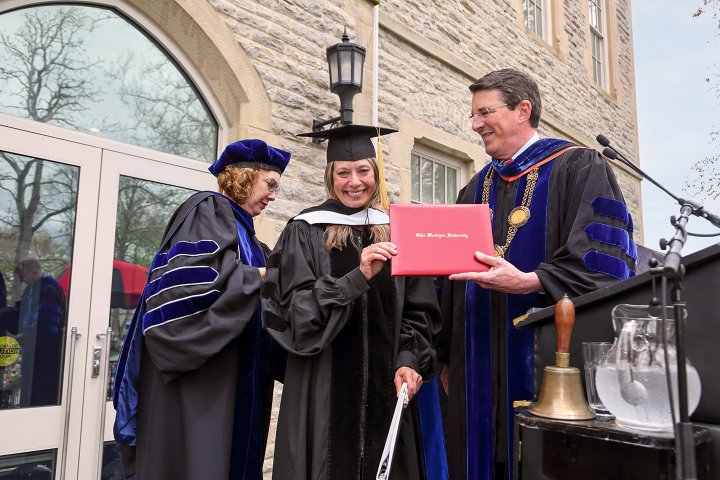Rock Solid
For 15 Years, Rock Jones Has Guided OWU Through Some of Its Most Difficult Challenges and Greatest Achievements
By Susan Headden ’77
It may be the very definition of an impossible job: Shape a vision for the future. Inspire students, appease faculty, and engage alumni. Manage unforgiving budgets. Hire and fire people. Navigate internal and external politics. Travel exhaustively, fundraise relentlessly, and open your family home to a nonstop stream of dinners and receptions.
No wonder the average tenure of a college president today is just 6.5 years.
Yet when Rock Jones retires as the 16th president of Ohio Wesleyan University June 30, he will have served for 15 years—longer than anyone except the university’s founding president.
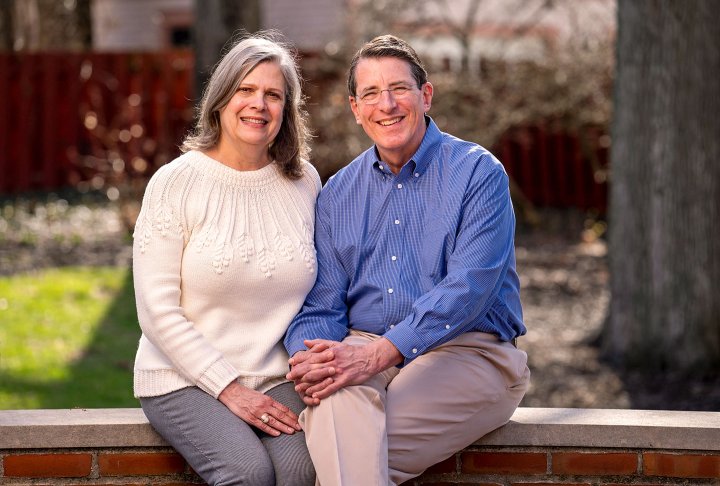
In his decade and a half of leadership, Jones has shepherded OWU through some of the most challenging years of its 181-year history. Confronted with the Great Recession on nearly his first day on the job, Jones went on to grapple with budget cuts, enrollment drops, demographic changes, political divisions, cultural upheaval, and a worldwide pandemic.
All the while, he has led Ohio Wesleyan through a period of innovation and renewal. Thanks largely to Jones’ fundraising efforts, the academic campus has been restored to its 19th-century roots while incorporating 21st-century technology. The residential campus now serves students in new and renovated surroundings that better connect to the academic campus and meet the needs of information-age students. Perhaps most important, the OWU curriculum has been enhanced and reimagined to more closely link the liberal arts to practical work.
Throughout these transformations, Jones has earned a reputation as an exceptionally effective and forwardthinking leader, and a collaborative, transparent, and principled administrator who combines the heart of a chaplain with the decisiveness of a CEO. Earnest and accessible, he is known as a listener, a trusted mediator, and a leader who gets things done. He leaves the university on solid footing, and with much good will. “Rock is a rock,” says Provost Karlyn Crowley.
Rock has always approached the job from a really grounded center.
“Rock comes at everything from a great moral and intellectual perspective, in terms of what is the right thing to do,” says John Milligan ’83, past president of the OWU Board of Trustees, who notes he’s observed Rock’s leadership for 13 years. “Being a college president is an incredibly difficult and time-consuming job. It’s actually more of a lifestyle than a job—24-7. And Rock has always approached the job from a really grounded center.”
Now, Jones says, it’s time for him to go.
“I think that there are seasons of leadership. There are seasons of life. And I feel incredibly fortunate to have been able to do this work for 15 years. And so as the Connect Today, Create Tomorrow campaign ended, and when we were coming to the next strategic planning process, it felt like an appropriate time to transition to a new season of leadership,” he says.
“And Melissa and I now have three grandchildren 800 miles away, so there’s a new season of life for us personally. It seemed there was a confluence that made this the right time.”
When Jones arrived on the OWU campus in July 2008, he had seen little reason to leave Hendrix College (his alma mater and that of his wife, Melissa), where he was happy in his role as a top administrator and enjoying extended family nearby. But then he participated in a three-day seminar emphasizing that the most effective presidencies come when the vocation of the leader is aligned with the mission of the institution.
At the end of the seminar, the participants were asked to list the characteristics of an institution they might want to lead. Jones talked about his commitment to the residential, undergraduate liberal arts experience.
“My interest was in a setting where the president can be deeply involved in the lives of students,” Jones recalls. “And I said I would like to be in a setting where the work of the small college is instrumental to the community, as opposed to being swallowed up in a large city. I said I’d like to be in a place that had a history of strength, but which aspired for more, and demonstrated evidence to achieve more.” And if the college was affiliated with the Methodist Church, so much the better. Shortly thereafter, a leader of the workshop called to tell Jones that Ohio Wesleyan was looking for a president—and it looked like he had written the profile.
Jones hardly fits the stereotype of the stiff, bow-tied administrator in the ivory tower. He’s got the big office, of course, and the tall stature and authoritative voice. But he’s also “Rock”—a friendly face on campus helping with the move-in, the cook flipping the pancakes for students during exam week, and the Battling Bishops’ Number One Fan, attending nearly every home sporting event and artistic performance whenever he’s in town.
It wasn’t the best dancing I’ve ever seen, but this was clearly a guy who wanted to connect with the students.
Waiting at a Sandusky Street stoplight while walking to work, Jones routinely engages students in conversation. Sharif Kronemer ’12, recalls one “Day on the JAY”—the traditional campus-wide celebration—when a group of students suddenly broke into a dance. Jones ran into the crowd and started jumping right along with them. “It wasn’t the best dancing I’ve ever seen,” Kronemer says, “but this was clearly a guy who wanted to connect with the students. It was totally impromptu.”
The custom was far different when Milligan attended OWU in the eighties. “When I was in college, we never would have called the president by his first name. But everybody knows Rock, and he knows everybody, which is remarkable. He is just an incredibly open and visible leader, and I think that’s why people feel so strongly about him—because they have engaged with him personally.”
Kronemer, now a post-doctoral fellow in neurology at the National Institutes of Health, had connected with Jones both as vice president and president of the student governing organization and as an athlete. In the former capacities, he attended biweekly meetings with top administrators and recalls Jones as a transparent and thoughtful leader. “The agenda was for the students and the university administration to sort of communicate with each other, to share ideas, and Rock was always really receptive to whatever we had to offer him. It wasn’t like you were figuratively at the table; you really were at the table.”
Kronemer adds an overarching thought: “The president is such an important person at a university. In lots of ways, they set the culture and the vibe. And that person can really make you feel like you’re at a place that you’re welcome at and that you’re proud to be at. And that’s what Rock did. He made Ohio Wesleyan a place that I was excited to tell people I was from.”
It’s All About Relationships
 It’s notable that Jones, who holds a master of divinity degree as well as a Ph.D., also once served as a college chaplain. At OWU, he sees the Methodist influence as a cultural, not a dogmatic, one, manifested in the university’s commitment to service, international reach, and holistic education. “John Wesley talked about the life of the warmed heart and the extended hand…that your faith gets lived out in the way you treat other people,” Jones explains. “We ought to be able to serve students regardless of their faith tradition, then serve them in a way that encourages their own growth.”
It’s notable that Jones, who holds a master of divinity degree as well as a Ph.D., also once served as a college chaplain. At OWU, he sees the Methodist influence as a cultural, not a dogmatic, one, manifested in the university’s commitment to service, international reach, and holistic education. “John Wesley talked about the life of the warmed heart and the extended hand…that your faith gets lived out in the way you treat other people,” Jones explains. “We ought to be able to serve students regardless of their faith tradition, then serve them in a way that encourages their own growth.”
Jones has often drawn on his pastoral skills in moments requiring that style of leadership, such as helping the campus cope with several student deaths in his first few years—and this spring. Most important, though, may be his exceptional skills as an attentive listener and relationship builder. His popular “Rock Tours” have kept him on the road many weeks out of the year, meeting with alumni in cities from San Francisco to Boston. As grueling as he has found the late nights and 4 a.m. wakeup calls, he is invariably energized by the people. “So much of this work is relational,” he says. “And it’s the relationships on the campus, the relationships with students, with faculty, with staff, and with alumni, and in particular with donors.”
Working effectively with donors, Jones says, requires far more listening than talking; only through the former, he says, can he understand benefactors’ passions and interests. “Donors are looking for alignments between their passions and the institution’s needs. And when those alignments happen, philanthropy can be one of the most rewarding things a person does. All that work is pastoral—the listening, the seeking of alignment, and the extraordinary opportunity to participate in what can be among life’s most meaningful experiences.”
Bricks, Mortar, and Megabytes
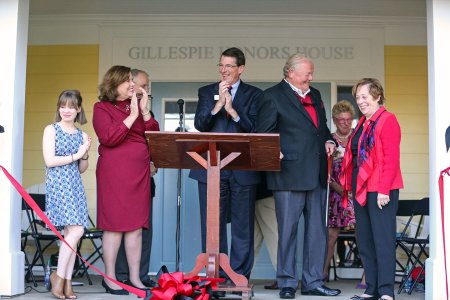 The bricks-and-mortar legacy of Rock Jones is apparent in capital improvements from one end of campus to the other. On the residential side, the new Bradford Milligan Hall provides apartment living for seniors; a reconfigured and renovated Smith Hall welcomes first-year students with a design that encourages them to mingle; three new duplexes and two new houses bring together students with mutual interests; and historic Stuyvesant Hall has been updated in a way that respects its grand colonial style.
The bricks-and-mortar legacy of Rock Jones is apparent in capital improvements from one end of campus to the other. On the residential side, the new Bradford Milligan Hall provides apartment living for seniors; a reconfigured and renovated Smith Hall welcomes first-year students with a design that encourages them to mingle; three new duplexes and two new houses bring together students with mutual interests; and historic Stuyvesant Hall has been updated in a way that respects its grand colonial style.
On the academic campus, the Elizabethan-style Merrick Hall, completed in 1873 and shuttered in 1985 (when the editor of the Transcript called it a “decrepit, bat-and-flea-infested mold farm”), shines anew as a favored gathering center and classroom space, and the colorfully sky-lit Slocum Hall boasts a top-down renovation that restores and protects its turn-of-thecentury beginnings. The elegantly designed Meek Aquatics and Recreation Center, renovated Branch Rickey Arena, Simpson Querrey Fitness Center, and Edwards Gymnasium provide top-notch facilities for the Battling Bishops.
This historic campus renewal springs from alumni giving of more than $93 million for capital projects during Rock’s tenure, a testament to the prodigious fundraising talents of Jones and tireless staff. It is also the result of some unsparing assessments of the facilities. In 2018, Jones asked a group of high school counselors for their thoughts after a tour of campus. Rock recalls: “The first person who spoke up said, ‘The curriculum is great, and we’re impressed with what we heard from the students about the faculty, and the center of the campus feels vibrant, but you will not get my students until you fix the residential campus.’ ”
It hit home. Jones then met with student tour guides, who told him tours go very well until they cross South Liberty Street.
A short while later, Jones led a board retreat on residential renewal that led to the plan for the Smith Hall renovation, the construction of Bradford Milligan, and other residential improvements, and a commitment to move ahead with about $55 million of work.
Gen Z Comes to Campus
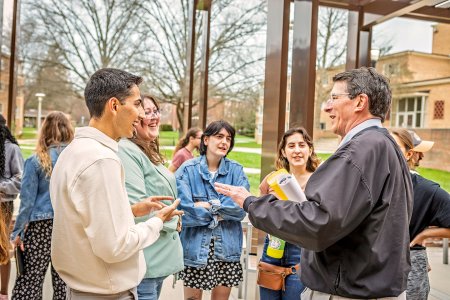 Jones’ long tenure also coincides with significant changes in the student body—in students’ habits, interests, and chosen paths of study. Those who were seniors his first year had not yet adopted Facebook, Instagram, or texting when they arrived on campus. Today, of course, they are digital natives and their phones have become vital appendages. “Students who are arriving today have no memory of a life before the iPhone,” Jones observes.
Jones’ long tenure also coincides with significant changes in the student body—in students’ habits, interests, and chosen paths of study. Those who were seniors his first year had not yet adopted Facebook, Instagram, or texting when they arrived on campus. Today, of course, they are digital natives and their phones have become vital appendages. “Students who are arriving today have no memory of a life before the iPhone,” Jones observes.
As Jones sees it, this modern phenomenon has both benefits and drawbacks. “On the one hand, the students are more connected than any past generation; they talk to their parents all the time, and they can communicate with people anywhere in the world,” he says. “But they’re also, in many cases, more isolated than ever.” Thus it is, for instance, that the new design of Smith Hall deliberately incorporates many common spaces along with shared, down-the-hall bathrooms.
“Particularly in that first year, we wanted people to get out of their rooms,” Jones says. “We want them learning to interact with others.”
Confronting Crises
Jones has been at the helm of OWU during an exceptionally difficult time for small private liberal arts colleges. More students (and their parents) are questioning the value of a private four-year experience, and a declining birthrate has left a shrinking pool of eligible candidates for colleges overall. From 2019 to 2021, post-secondary enrollment in the United States dropped by 6 percent.
The beautifully renovated buildings, Jones says, “are just vessels for what happens inside of them.” So, on top of the physical improvements, he has overseen a revamped curriculum that draws clearer connections with jobs and careers for graduates and added cocurricular programs proven to attract good students and enhance their experience. The latter includes marching band, which put about 60 student musicians on the field this year, and a wrestling program that has attracted more than 30 students, most of whom Jones believes would not be at OWU otherwise. Meanwhile, new majors include public health, business administration, communication, and quantitative economics.
“We’re trending well, and I expect we’ll be able to at least match, if not exceed, last year’s [enrollment results],” Jones says. He notes that the university also has enjoyed a 3 percentage point increase in retention this year—a key measure that reflects how prepared students are for the rigors of an OWU education and how well the college keeps them academically stimulated and intellectually and socially engaged.
Marjorie Hass, president of the Council of Independent Colleges, notes that OWU now ranks in the top 15 percent of all CIC institutions for student retention.
Jones, like all university presidents, has confronted countless other challenges in his many years at the helm of OWU. None could have been more unexpected or more disruptive than a global pandemic.
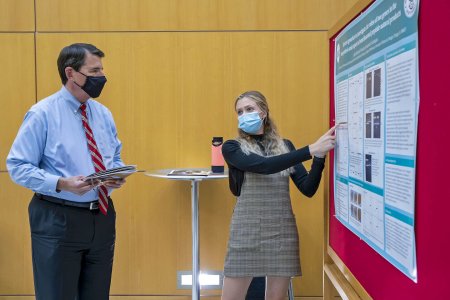 Jones says he is “pretty amazed” at how the university came through the COVID-19 crisis. In mid-March 2020, the college was on spring break, and Jones was traveling to St. Louis, Chicago, and Birmingham. He suddenly had to make the call to postpone students’ return for a week. That decision turned out be one of the easier ones. Over the next few days, it became clear that the COVID numbers would only get worse. Fortunately, Jones and the leadership team had the counsel of Milligan, board chair at the time and a pharmaceutical executive with a Ph.D. in biochemistry who had spent 30 years planning for pandemics.
Jones says he is “pretty amazed” at how the university came through the COVID-19 crisis. In mid-March 2020, the college was on spring break, and Jones was traveling to St. Louis, Chicago, and Birmingham. He suddenly had to make the call to postpone students’ return for a week. That decision turned out be one of the easier ones. Over the next few days, it became clear that the COVID numbers would only get worse. Fortunately, Jones and the leadership team had the counsel of Milligan, board chair at the time and a pharmaceutical executive with a Ph.D. in biochemistry who had spent 30 years planning for pandemics.
“It was really tough,” Jones says. “But John was a tremendous resource, and he knew all the players, the folks from the CDC.” At first, Jones recalls, the team simply lacked the data upon which to make a reasoned decision. “One of the things I said to the team is that we’re going to have to make decisions quickly without the time or the information that we normally want.”
Quickly, spring break was extended a week—then classes were switched to an online format through the rest of the school year.
“I remember driving around campus at six o’clock [in late March], and it was now getting light at that time of year, and there is not a car in a parking lot, not a light on in a building. It was a killer,” Jones says. “And a week later, we should have been having baseball, softball, lacrosse, track and field, tennis, theatre and music rehearsals. And there’s nothing happening.”
The loss of human engagement is something Jones says he felt as profoundly as the students did. “For the first few weeks, it was so intense that there was no time to do anything. I don’t think I realized the effect it was having on me until the spring of ’22. I was a little concerned about my health, and I realized I hadn’t been doing the things that energize me. As I was getting back into it, and I was feeling better, I realized that the things that give me energy had been taken away.”
The turmoil of the pandemic was exacerbated across the nation and at OWU and other colleges in 2020 with the killings of George Floyd, Breonna Taylor, Andre Hill (in Columbus), and the ensuing protests. Jones and OWU officials reached out through a series of online town hall sessions—to connect with students, parents, and alumni and to give them a forum to connect with the entire university community.
Jones initiated the OWU Diversity, Equity, and Inclusion Action Plan “to create meaningful and immediate change on campus,” hired the university’s first chief diversity officer, and led a Board of Trustees retreat devoted solely to achieving the goal of “inclusive excellence.”
Dawn Chisebe, OWU’s chief diversity officer, says, “Rock has been a persistent advocate for students of color at OWU. He brought together students, alumni, and funders to rebuild the House of Black Culture, and following the killings of George Floyd, Breoanna Taylor, and so many others, he truly listened to students and pushed to create and implement a Diversity, Equity, and Inclusion Action Plan, which continues to expand opportunity and improve life at OWU.”
As devastating as the pandemic and social upheaval were, OWU was able to weather the financial impact because it had already begun university-wide reviews of administrative processes and academic offerings. The administrative review resulted in $10 million in cost reductions, including the elimination of 44 positions (30 of them were filled at the time), and the academic review resulted in the elimination of 18 majors and a reduction in full-time faculty from 128 to 100. Nearly all the faculty reductions were made through an early-retirement program.
“The reduction was an important thing to do, and the university is now stronger and in a much better position to go forward,” Jones says. “But it was very hard. There were maybe five positions of tenured faculty, and the hardest thing I’ve ever done was calling those five people.” Moreover, the isolation caused by the pandemic, he says, “meant the grief process didn’t happen as it could have.”
In the face of adversity that at times became so vitriolic and personal in relation to our COVID decisions, he remained steady.
Provost
Still, Jones gets high marks for his handling of those turbulent times. There were no lawsuits or nasty headlines. And because Jones had laid a foundation of trusting relationships, he had the benefit of a patient and supportive board of trustees, along with a relatively understanding faculty.
“Rock is solid, stable, and firm in the face of adversity and challenge,” says Crowley. “If you had to go through a crisis with someone, it would be him. He acts from a strong and clear moral compass that does not deviate when external pressures are extreme. In the face of adversity that at times became so vitriolic and personal in relation to our COVID decisions, he remained steady.”
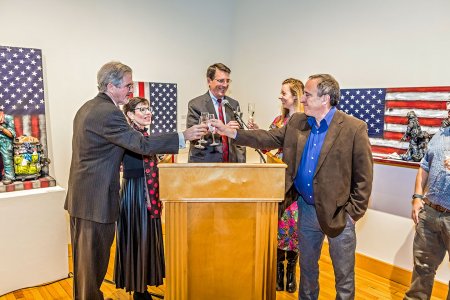 Jones credits the faculty. “Because many senior faculty took early retirement, we didn’t have to make some of the hard decisions we would have otherwise. But even that was hard, because some of these faculty members were retiring earlier than they had planned. But they retired so that younger colleagues would not be affected.” Overall, he says, “the campus had a sufficient understanding of how the financial structure of small colleges is changing. And that we couldn’t keep going the way we were going.”
Jones credits the faculty. “Because many senior faculty took early retirement, we didn’t have to make some of the hard decisions we would have otherwise. But even that was hard, because some of these faculty members were retiring earlier than they had planned. But they retired so that younger colleagues would not be affected.” Overall, he says, “the campus had a sufficient understanding of how the financial structure of small colleges is changing. And that we couldn’t keep going the way we were going.”
Jones and other university leaders also were coming to the realization that OWU could not best serve current students without significant changes to the curriculum. So in one of the final initiatives during his presidency, in 2022 the OWU faculty completed the first overhaul of the university’s academic program in nearly 50 years.
The new academic framework is built on three key components designed to ensure that all OWU students can think critically, reason analytically, and communicate effectively. General academic requirements, which traditionally had been met through courses in specific departments, now focus on producing the core competencies students need to be productive employees and engaged citizens. Students also will be required to take a first-year seminar centering on a complex problem that teaches them to think deeply, broadly, and ambitiously. Finally, all students will be required to gain hands-on experience through the OWU Connection, a program that has long provided students with service learning, internships, and field research, but which had not been required.
Jones says such fundamental changes could happen only through “the leadership of the faculty.” He says, “The president can help nudge the faculty and, more importantly, the president can work with donors to provide resources for the faculty, but the credit goes to the faculty for doing this work.”
He has completely reimagined the board of trustees for the modern institution.
Chair of the Department of Biological Sciences and a member of the University Governance Committee
Nevertheless, Chris Wolverton, chair of the Department of Biological Sciences and a member of the University Governance Committee, says, “Rock had the vision to give it that overarching structure.”
And Jones has been the leading advocate for the OWU Connection, which was launched early in his tenure. The program has been enhanced considerably by his success both in raising close to $20 million to fund it and in encouraging alumni to create internship opportunities for students. The program has transformed the OWU experience for students and faculty.
“Rock’s vision and leadership with the OWU Connection bolstered some of the most poignant educational experiences I—and others—have had at OWU,” says Mary Anne Lewis Cusato, associate professor of modern foreign languages.
“The OWU Connection has been at the heart of my work with students and colleagues since my first semester almost 10 years ago,” she says. “The OWU Connection has pushed us beyond our comfort zone through research, travel, interviews, proposals, internships, independent studies, and presentations. And it has brought learning to life.”
Jones has also worked to create a far deeper engagement between the board and the faculty, while recruiting to the board a diverse group of experts with particular skills and backgrounds.
Wolverton notes, “He has completely reimagined the board of trustees for the modern institution.”
Looking Ahead
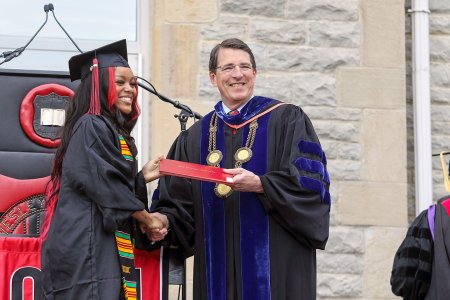 While Ohio Wesleyan’s enrollment grew this year, Jones acknowledges that OWU and other small colleges must get a handle on tuition prices and related discounting. The intense competition for students, which leads to discounting, is “the existential problem for American higher education, and, in particular, for the vast majority of small colleges,” Jones says. “The supplyand- demand curve is not in our favor. And in the future, the scariest outcome would be that it just drives the [tuition] price to zero. That’s not sustainable.”
While Ohio Wesleyan’s enrollment grew this year, Jones acknowledges that OWU and other small colleges must get a handle on tuition prices and related discounting. The intense competition for students, which leads to discounting, is “the existential problem for American higher education, and, in particular, for the vast majority of small colleges,” Jones says. “The supplyand- demand curve is not in our favor. And in the future, the scariest outcome would be that it just drives the [tuition] price to zero. That’s not sustainable.”
The answer, he says, lies in public and individual investment. “This political narrative about free college or [forgiven] student debt feeds the notion that you shouldn’t have to pay for college. I think college is both a public good and a private benefit. That’s why the public invests in higher education, but it needs to be a combined investment, and that narrative is being lost.”
Jones is intent on reclaiming the narrative, convinced that the small institutions that will thrive are those with broad, reliable, and growing philanthropic support. “That’s a benefit for Ohio Wesleyan,” he says, “because we do have generous philanthropic support, and that’s going to be more important than ever.”
The future enrollment strategy, Jones says, likely will target a handful of out-state locations. Partly because of alumni support in the region, the Northeast remains important, but fewer students come from the Northeast than they once did. In addition to Ohio, home to many competing colleges, Jones says the university is looking to cities such as Nashville, Raleigh-Durham, Washington, Austin, and Denver. “These are areas with vibrant populations, and more likely to have the students looking for our kind of place.”
Student-athletes also are getting a special look. “Families will choose a place like Ohio Wesleyan for an athlete that they might not choose for one of their other children,” Jones says. “One of the things I’ve really appreciated here is how athletes are involved in the total life of the student. Four times in my tenure, the student body president was a varsity athlete.”
Says Athletic Director Doug Zipp: “Rock is one of the biggest advocates for athletes that I’ve had the pleasure of working with—and every student knows it.”
After they leave Delaware in July, Rock and Melissa, who will soon celebrate 40 years of marriage, will divide their time between their summer home on Ocracoke Island, North Carolina, and a new house near Hendrix in Conway, Arkansas, where they still have family (including all their grandchildren) and lifelong friends. Jones says he looks forward to traveling, cooking, gardening, and reading. A fan of good fiction and biography, he has come to rely on the owner of Ocracoke’s independent bookstore for suggestions. “I say, ‘O.K., Leslie, what do I need to read this summer?’ And she’ll pull five novels off the shelf.”
Professionally, he’s going to take a pause. “I want to give myself time to just collect my thoughts. Then I know I’ll need something else to do,” he says. Another leadership position? Writing? He doesn’t know, except to say that whatever he does will keep him connected to the field of education. “But I have not wanted to lose a part of my last year here thinking about that,” he says.
So, he has been taking care of administrative business and engaging alumni on his final Rock Tour. On May 13, he will help launch the Class of 2023 into the world—a world he hopes will bring them rewarding careers and rich opportunities for public service. He hopes, too, that they will leave their now-alma mater with a sense of gratitude and fulfillment.
“I tell prospective students that when they graduate I don’t want them to look back to what they were hoping to happen in college and say, ‘I picked a place where that is what happened.’ Instead, I want them to look back and say, ‘I picked a place where things could happen that I never imagined, and I became a person I didn’t know I could become.’ That’s what it means to be a college that changes lives.”
Rock Jones might say that he chose such a university, himself.
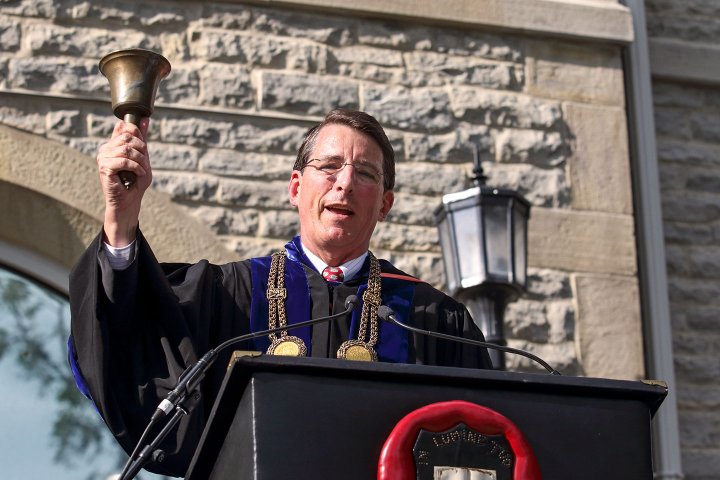
Pulitzer Prize winning journalist Susan Headden ’77 is a communications consultant based in Washington, D.C.
A Rock Jones Photo Retrospective
Students’ Friend and Mentor
From meeting with students in residence halls and dining rooms to attending every performance, athletic contest, and academic event possible, Rock Jones has been ubiquitous in student life activities at OWU. He was even duct-taped to a wall as part of a student fundraiser.
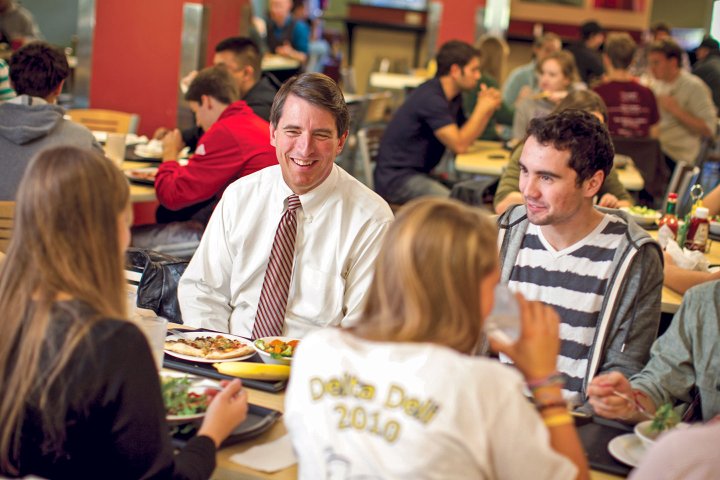
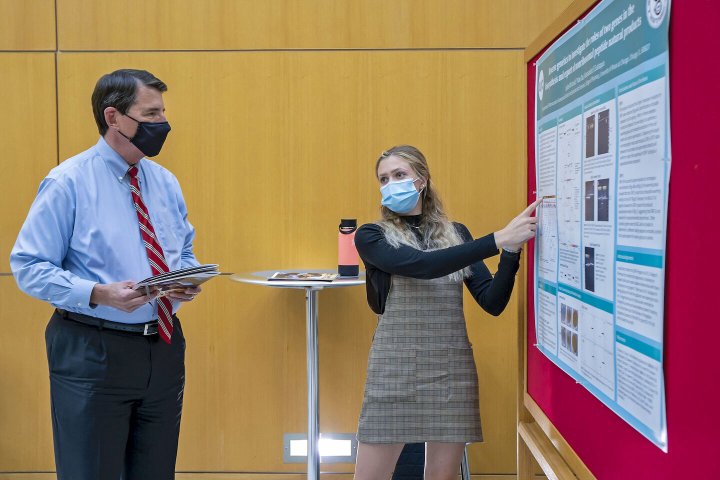
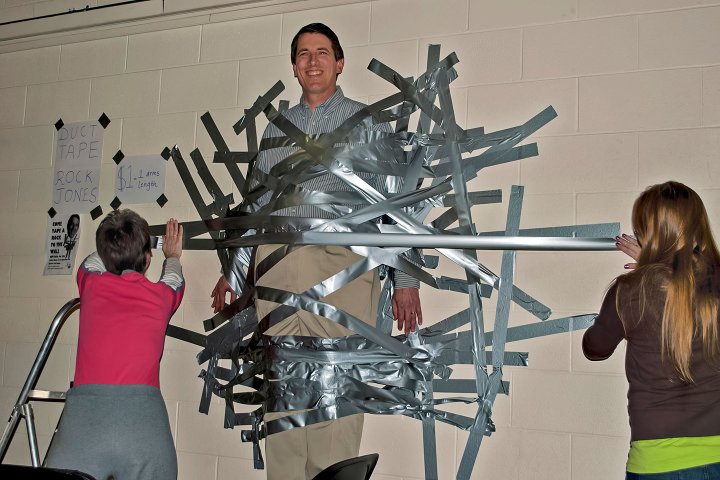
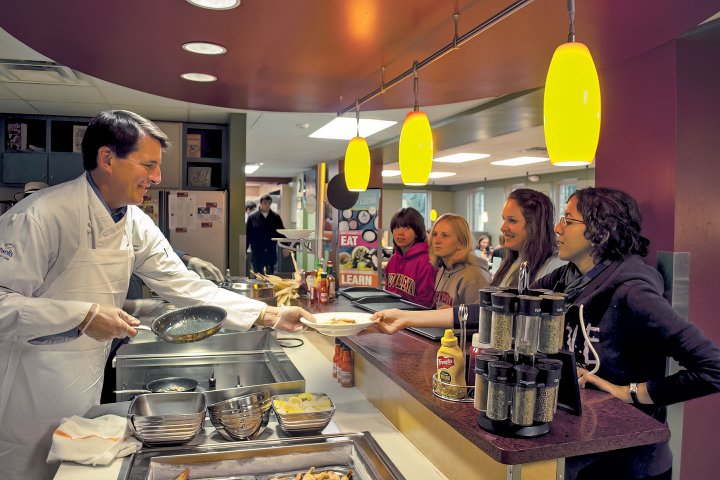
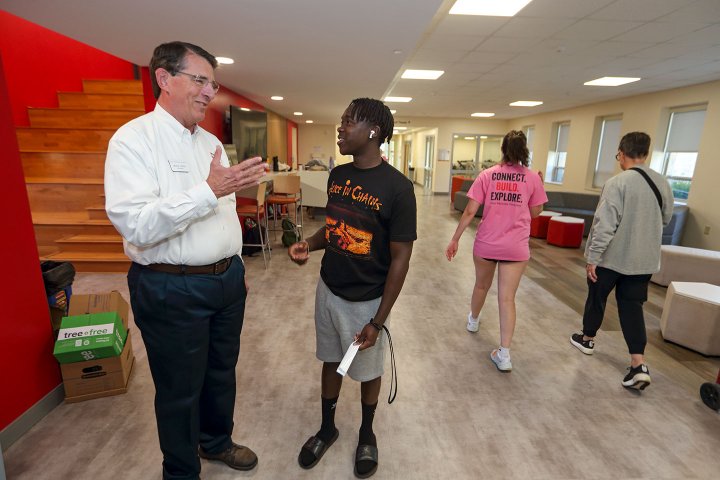
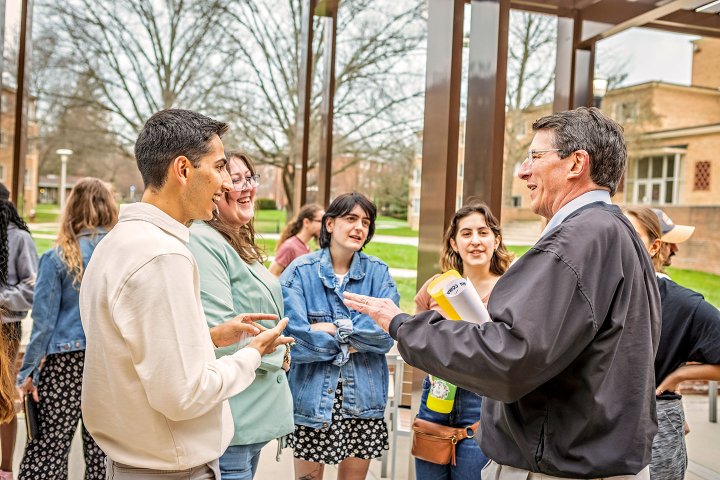
Campus Host
Rock Jones has welcomed to campus dozens of distinguished leaders from around the world, such as the late Congressman John Lewis (below) and broadcast journalist Byron Pitts ’82 (middle). And like the perfect host, every year he lends a hand to help students move into their OWU residence halls (bottom). In the photo, he gets assistance from 2022 Special Thanks and Recognition (STAR) Award-recipient Shane Andrews.
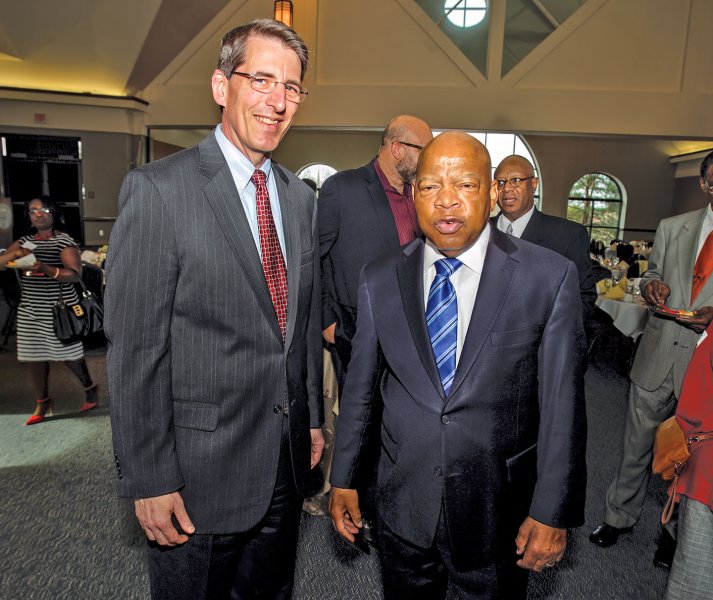

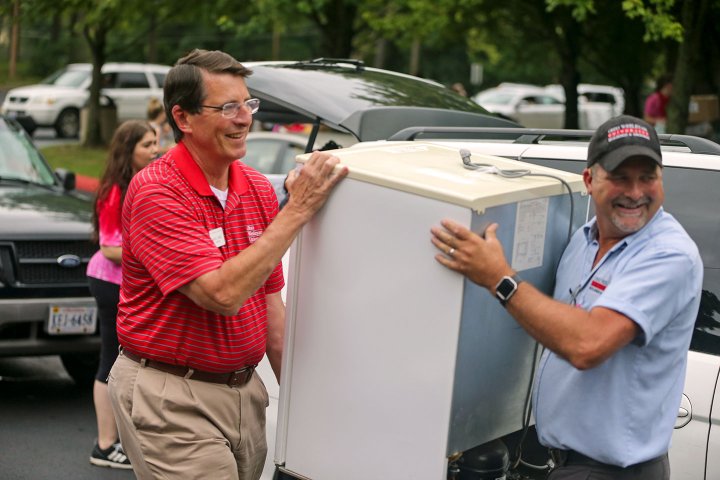
Fundraiser
Rock’s passion for OWU has helped him raise hundreds of millions of dollars for the university. Under his leadership, OWU conducted the largest campaign in its history and secured the largest gift ever. In the photos, Rock and VP for Advancement Natalie Doan ’03 celebrate the $10 million gift from an anonymous alumni donor (below), and he kicks off the public portion of the record-setting Connect Today, Create Tomorrow campaign with (bottom, from left) campaign co-chairs John Milligan ’83, Kathie Bradford Milligan ’83, Nancy McGinty, and Kevin McGinty ’70.
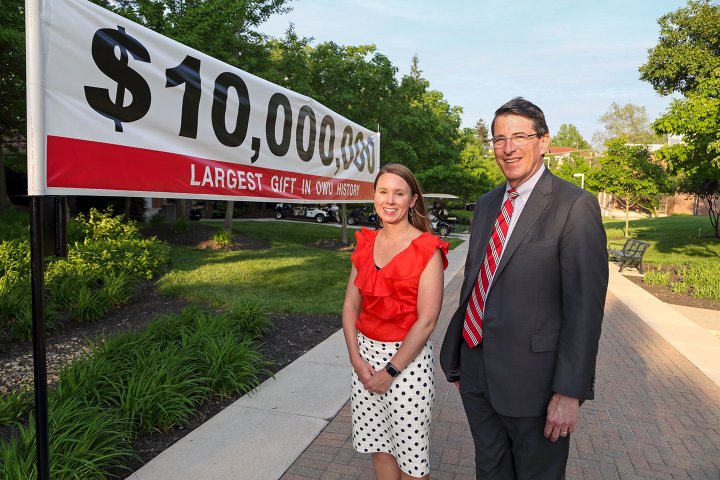
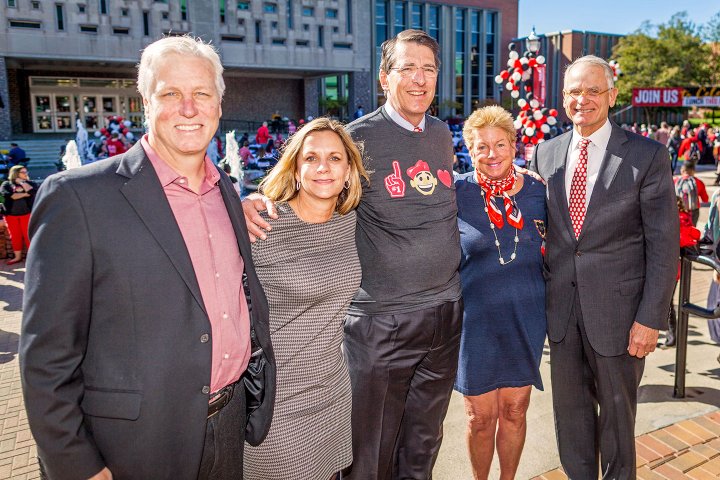
Builder
Rock and the advancement team’s prowess at fundraising have spurred a construction and renovation boon that has remade the campus. The many groundbreakings and ribbon cuttings have included the Simpson Querrey Fitness Center, Bradford Milligan Hall apartment building, Delaware Entrepreneurial Center, six SLU houses, and Gillespie Honors House.
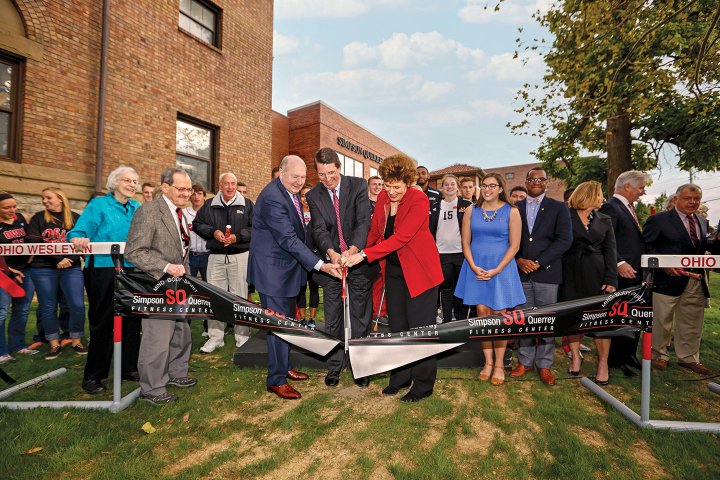
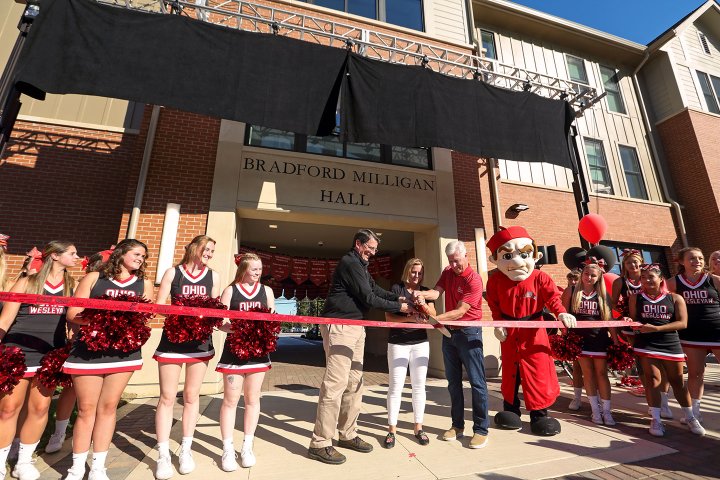
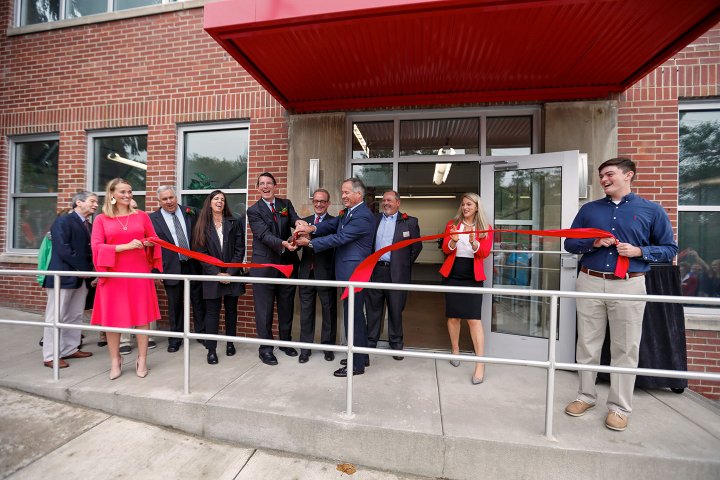
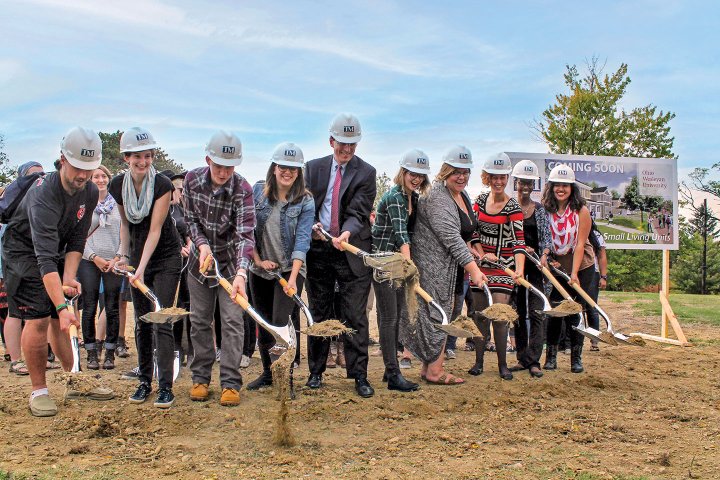
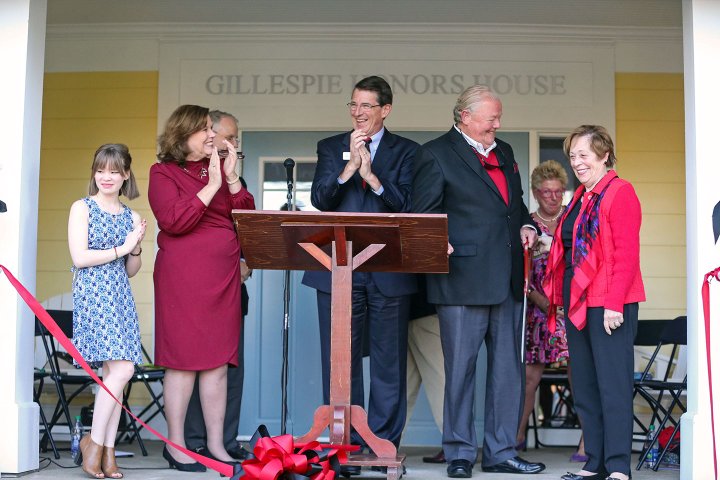
Faculty & Staff Promoter
During Rock’s tenure, OWU created the Special Thanks and Recognition (STAR) Award to honor the staff member of the year. In the photo below, he presents the 2018 award to Fody Frentsos ’84, coordinator of athletic facilities and equipment. Rock also has overseen the creation and expansion of faculty opportunities through the OWU Connection and academic programs such as the Thomas W. Palmer ’69 and Susan Palmer Global Scholars Program. At bottom, he toasts the endowment of the program with (from left) Tom and Susan Palmer, and program co-directors Mary Anne Lewis Cusato and Jeremy Baskes (not pictured is co-director Nathan Rowley).
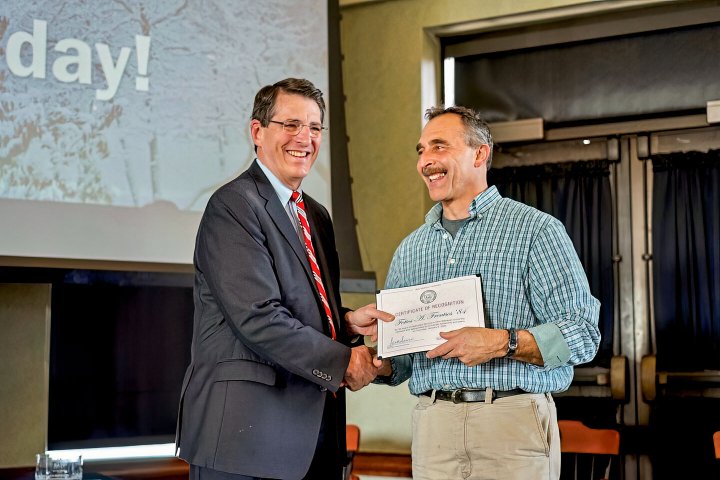
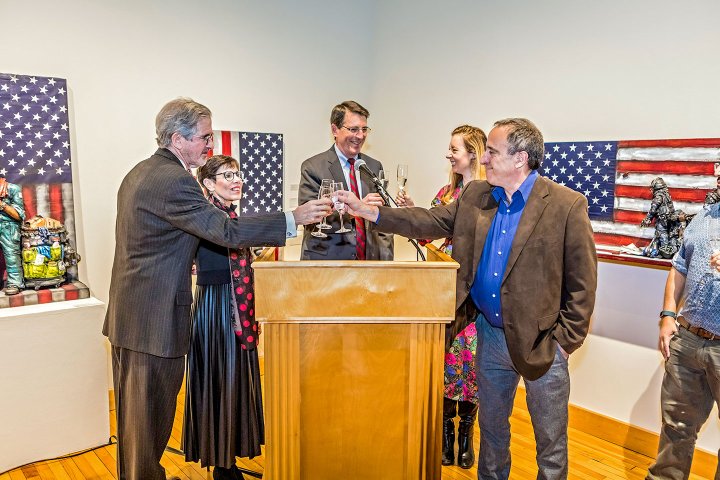
Alumni Cheerleader
Whether leading the homecoming march to Selby Stadium (top), greeting families returning for Reunion Weekend, or celebrating with alumni on the road (like this group from the Class of 2012 in Washington, D.C., bottom), Rock is a fervent cheerleader for the university and advocate for alumni to stay connected with OWU and current students.
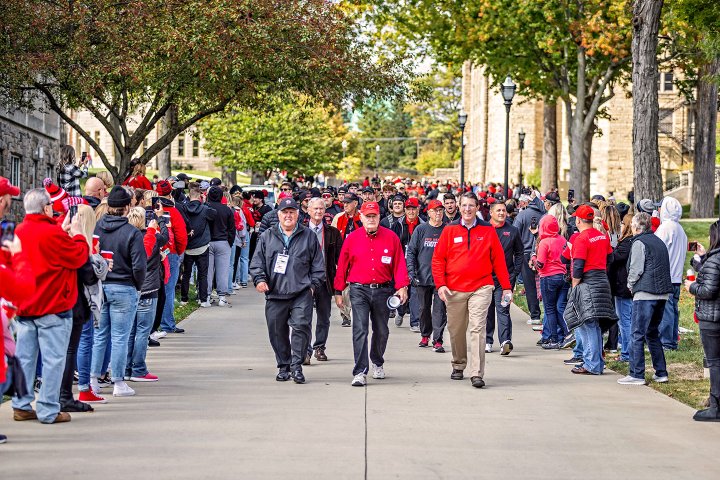
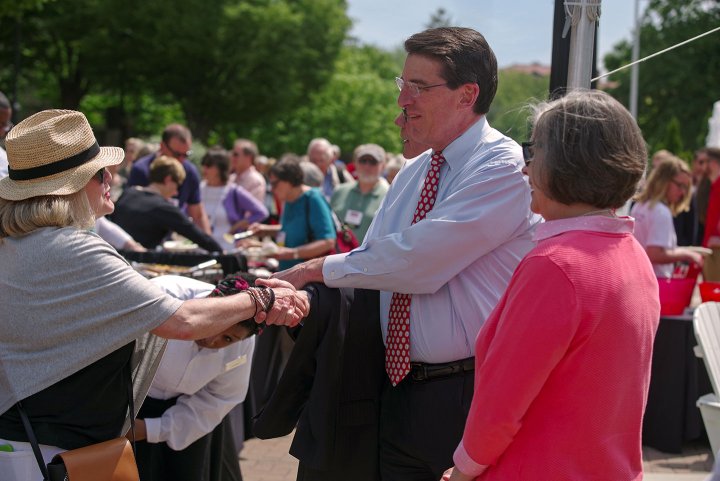
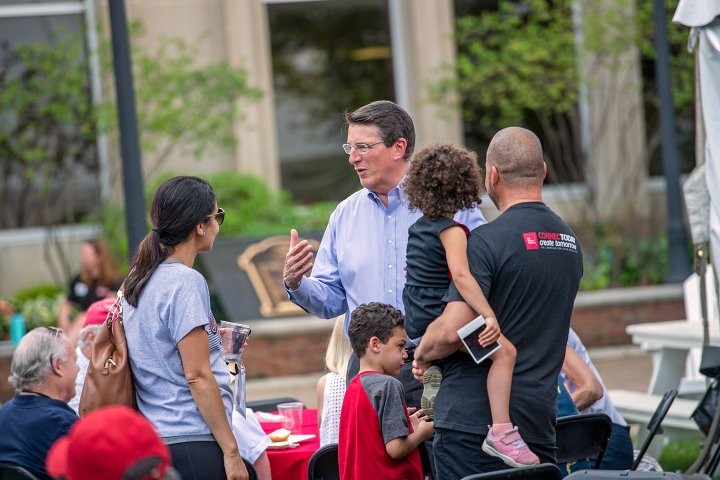
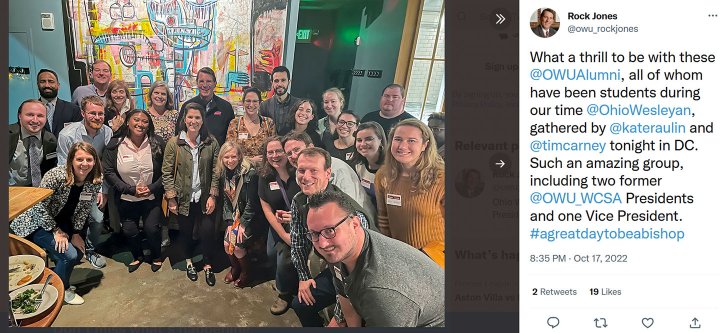
Head of State
As OWU’s 16th president, Rock has presided at the convocation and commencement of more than 5,000 students. He also has bestowed honorary degrees on dignitaries such as Dr. Amy Acton (middle), director of the Ohio Department of Health during the pandemic. And he has opened and closed 15 academic years with the ringing of OWU’s historic bell.
